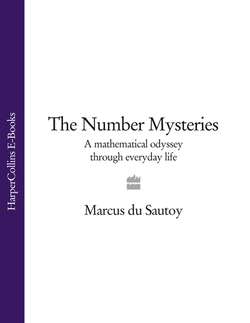Читать книгу The Number Mysteries: A Mathematical Odyssey through Everyday Life - Marcus Sautoy du - Страница 31
How Archimedes improved on Plato’s footballs
ОглавлениеWhat if you tried to smooth out some of the corners of Plato’s five footballs? If you took the 20-faced icosahedron and chopped off all the corners, then you might hope to get a rounder football. In the icosahedron, five triangles meet at each point, and if you chop off the corners you get pentagons. The triangles with their three corners cut off become hexagons, and this so-called truncated icosahedron is in fact the shape that has been used for footballs ever since it was first introduced in the 1970 World Cup finals in Mexico. But are there other shapes made from a variety of symmetrical patches that could make an even better football for the next World Cup?
It was in the third century BC that the Greek mathematician Archimedes set out to improve on Plato’s shapes. He started by looking at what happens if you use two or more different building blocks as the faces of your shape. The shapes still needed to fit neatly together, so the edges of each type of face had to be the same length. That way you’d get an exact match along the edge. He also wanted as much symmetry as possible, so all the vertices—the corners where the faces meet—had to look identical. If two triangles and two squares met at one corner of the shape, then this had to happen at every corner.
The world of geometry was forever on Archimedes’ mind. Even when his servants dragged a reluctant Archimedes from his mathematics to the baths to wash himself, he would spend his time drawing geometrical shapes in the embers of the chimney or in the oils on his naked body with his finger. Plutarch describes how ‘the delight he had in the study of geometry took him so far from himself that it brought him into a state of ecstasy’.
It was during these geometric trances that Archimedes came up with a complete classification of the best shapes for footballs, finding 13 different ways that such shapes could be put together. The manuscript in which Archimedes recorded his shapes has not survived, and it is only from the writings of Pappus of Alexandria, who lived some 500 years later, that we have any record of the discovery of these 13 shapes. They nonetheless go by the name of the Archimedean solids.
Some he created by cutting bits off the Platonic solids, like the classic football. For example, snip the four ends off a tetrahedron. The original triangular faces then turn into hexagons, while the faces revealed by the cuts are four new triangles. So four hexagons and four triangles can be put together to make something called a truncated tetrahedron (Figure 2.05).
FIGURE 2.05
In fact, seven of the 13 Archimedean solids can be created by cutting bits off Platonic solids, including the classic football of pentagons and hexagons. More remarkable was Archimedes’ discovery of some of the other shapes. For example, it is possible to put together 30 squares, 20 hexagons and 12 ten-sided figures to make a symmetrical shape called a great rhombicosidodecahedron (Figure 2.06).
FIGURE 2.06
It was one of these 13 Archimedean solids that was behind the new Zeitgeist ball introduced at the World Cup in Germany in 2006 and heralded as the world’s roundest football. Made up of 14 curved pieces, the ball is actually structured around the truncated octahedron. Take the octahedron made up of eight equilateral triangles, and cut off the six vertices. The eight triangles become hexagons, and the six vertices are replaced by squares (Figure 2.07).
FIGURE 2.07
Perhaps future World Cups might feature one of the more exotic of Archimedes’ footballs. My choice would be the snub dodecahedron, made up of 92 symmetrical pieces—12 pentagons and 80 equilateral triangles (Figure 2.08).
FIGURE 2.08
Pictures of all 13 Archimedean solids can be found at http://bit.ly/Archimedean or by using your smartphone to scan this code.
Even to the last, Archimedes’ mind was on things mathematical. In 212BC the Romans invaded his home of Syracuse. He was so engrossed in drawing diagrams to solve a mathematical conundrum that he was completely unaware of the fall of the city around him. When a Roman soldier burst into his rooms with sword brandished, Archimedes pleaded to at least be able to finish his calculations before he ran him through. ‘How can I leave this work in such an imperfect state?’ he cried. But the soldier was not prepared to wait for the QED, and hacked Archimedes down in mid-theorem.
